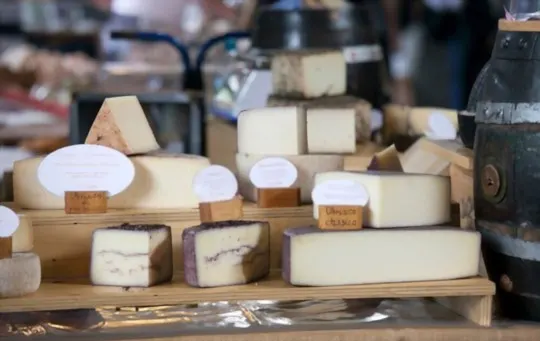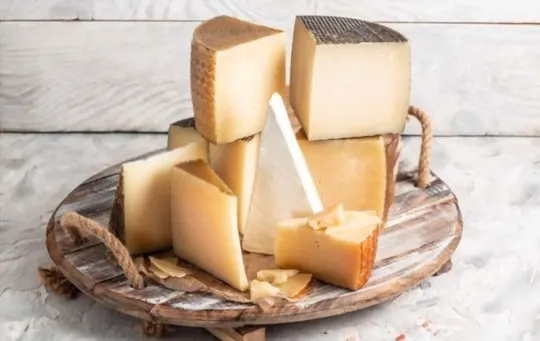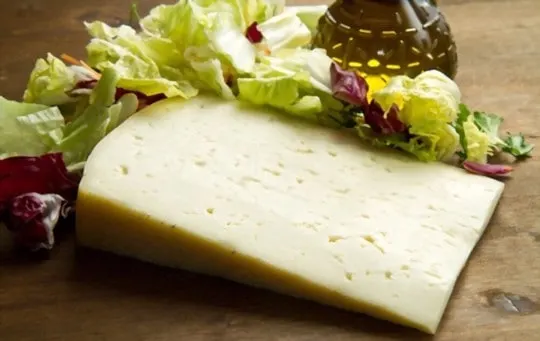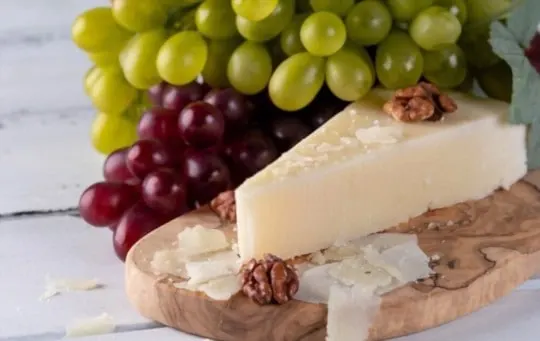Oh, the love we have for Parmesan cheese! Its bold flavor boosts everything from pasta to salads.
But sometimes, we’ve gotta work with what’s in the kitchen or deal with dietary needs.
Finding a good substitute for Parmesan isn’t a hassle.
It’s about getting creative and giving other cheeses a moment to shine.
We’re here to guide you through our top picks for alternative cheeses that still bring that umami kick.
No need to stress over missing Parmesan in your next dish.
Our lineup promises to keep your meals exciting, with options you might not have considered before.
Stay with us as we dive into these cheesy wonders, perfect for any Parmesan-free situation.
What is Parmesan Cheese?

Parmesan cheese is a hard, dry cheese made from cow’s milk.
It is named after the city of Parma in Italy, where it was first produced.
It is also often grated over food as a garnish.
Parmesan has a rich, nutty flavor that improves with age.
When aged for two years or more, the cheese develops an intense flavor perfect for grating over pasta or salads.
The cheese is made by curdling milk with rennet, separating the solid curds from the whey.
The curds are then cooked and pressed to form a hard block of cheese.
Parmesan cheese can be stored for up to two years without losing its flavor.
Parmesan cheese is an excellent source of protein and calcium.
It is also a good source of phosphorus and vitamin A.
Parmesan cheese is low in fat and calories, making it a healthy choice for those watching their weight.
So, whether you’re grating it over pasta or eating it by the chunk, Parmesan cheese is delicious and nutritious food that everyone can enjoy.
The 5 Best Substitutes for Parmesan Cheese
Parmesan cheese is a popular ingredient known for its rich and savory flavor.
However, if you’re in need of a substitute or want to explore different options, there are several alternatives available.
In this guide, we will compare the top 5 substitutes for Parmesan cheese, discussing their key characteristics and suggesting proper ratios to help you find suitable alternatives.
| Substitute | Key Characteristics | Proper Ratio |
|---|---|---|
| Granada Padano | Nutty and fruity flavor; slightly grainy texture; aged for at least 9 months | Use an equal amount of Granada Padano as a substitute for Parmesan cheese |
| Piave Cheese | Sweet and nutty flavor; firm and crumbly texture; aged for at least 12 months | Use an equal amount of Piave cheese as a substitute for Parmesan cheese |
| Manchego Cheese | Buttery and slightly tangy flavor; creamy and smooth texture; made from sheep’s milk | Use an equal amount of Manchego cheese as a substitute for Parmesan cheese |
| Asiago Cheese | Nutty and slightly sweet flavor; firm and creamy texture; available in aged and fresh varieties | Use an equal amount of Asiago cheese as a substitute for Parmesan cheese |
| Romano Cheese | Sharp and salty flavor; hard and granular texture; aged for at least 5 months | Use an equal amount of Romano cheese as a substitute for Parmesan cheese |
Now, let’s dive into each substitute in more detail:
1. Granada Padano
First up is Granada Padano, a hard cheese perfect for grating.
It has a savory, slightly nutty flavor that pairs well with dishes – from pasta to salads.
Granada Padano is one of my personal favorites, and I always keep a block in my fridge.
It’s an affordable cheese that’s widely available, so there’s no excuse not to try it.
When it comes to hard cheeses, Granada Padano is a great choice.
It has a savory flavor with a hint of nuttiness, making it versatile enough to pair with dishes.
Plus, it’s affordable and easy to find – so there’s no excuse not to give it a try.
- Key Characteristics: Granada Padano offers a nutty and fruity flavor with a slightly grainy texture. It is aged for at least 9 months, giving it a complex and robust taste.
- Proper Ratio: Use an equal amount of Granada Padano as a substitute for Parmesan cheese. Adjust the quantity based on personal preference and desired taste.
2. Piave Cheese

Piave is a hard, pressed cows’ milk cheese from the north-eastern Italian region of Veneto.
It has a crumbly texture and a nutty, slightly sweet flavor.
Piave is made from whole milk and has a minimum fat content of 30%.
The cheese is named after the River Piave, which flows through the province of Belluno, where the cheese is produced.
Piave has been granted DOP (protected designation of origin) status, which means it can only be produced in certain areas using traditional methods.
Piave is a versatile cheese that can be used in various recipes or enjoyed on its own.
It pairs well with fruit, crackers, and bread.
Piave is also an excellent cooking cheese and can be used in place of Parmesan in many dishes.
Whether you’re looking for a new cheese to add to your repertoire or want to try something different, Piave is worth seeking out.
- Key Characteristics: Piave cheese has a sweet and nutty flavor with a firm and crumbly texture. It is aged for at least 12 months, resulting in a rich and intense taste.
- Proper Ratio: Use an equal amount of Piave cheese as a substitute for Parmesan cheese. Consider adjusting the quantity based on the recipe’s requirements and your personal preference.
3. Manchego Cheese

Manchego is a traditional Spanish cheese made from the milk of Manchego sheep.
The cheese has a distinctive flavor that is often described as nutty or grassy, and it is commonly used in Spanish recipes.
Manchego is also one of the most popular types of cheese for Tapas, and it is often served with olives or bread.
The cheese can be either young or aged, and the aging process gives the cheese a more intense flavor.
Manchego is also an excellent source of protein and calcium, making it a healthy choice for cheese lovers.
When shopping for Manchego cheese, look for a brand made in Spain, and be sure to check the expiration date.
Manchego cheese can be enjoyed in many different ways, and it is a versatile cheese that can be used in both cooked and uncooked dishes.
Try Manchego cheese in a grilled cheese sandwich, or use it to top a salad or pasta dish.
Manchego is also delicious when melted and used as a dip for bread or vegetables.
- Key Characteristics: Manchego cheese offers a buttery and slightly tangy flavor with a creamy and smooth texture. It is made from sheep’s milk, providing a distinct taste.
- Proper Ratio: Use an equal amount of Manchego cheese as a substitute for Parmesan cheese. Adjust the quantity based on the recipe and the desired level of tanginess.
4. Asiago Cheese

Asiago cheese is a delicious and versatile cheese that originates from the Asiago plateau in Italy.
The cheese is made from cow’s milk, and it has a mild, nutty flavor that makes it perfect for both cooked and raw dishes.
Asiago cheese is also very versatile, and it can be used in everything from pizza and pasta to salads and soup.
In addition, Asiago cheese pairs well with both red and white wines.
The cheese has a firm texture and a nutty, slightly sweet flavor.
It is often used for grating or shredding, and it can also be eaten as a table cheese.
So, if you’re looking for a delicious and versatile cheese to add to your cooking repertoire, Asiago cheese is a great choice.
- Key Characteristics: Asiago cheese has a nutty and slightly sweet flavor with a firm and creamy texture. It is available in aged and fresh varieties, allowing for versatility in different recipes.
- Proper Ratio: Use an equal amount of Asiago cheese as a substitute for Parmesan cheese. Adjust the quantity depending on the desired level of nuttiness and sweetness.
5. Romano Cheese

Another great substitute for Parmesan is Romano cheese.
This hard, salty cheese is made from sheep’s milk and has a sharp, piquant flavor.
It’s perfect for grating over pasta dishes or used in place of Parmesan in recipes.
Romano cheese can be difficult to find outside of Italy, but it’s worth trying if you can get your hands on some.
In terms of flavor, Romano cheese is very similar to Parmesan.
It’s a bit saltier and has a stronger flavor, but it’s still a great option for those who can’t have cow’s milk products.
When choosing a Romano cheese, look for one aged for at least two years.
This will give it a more intense flavor that can stand up to other strong flavors in your dish.
- Key Characteristics: Romano cheese has a sharp and salty flavor with a hard and granular texture. It is aged for at least 5 months, imparting a robust taste to dishes.
- Proper Ratio: Use an equal amount of Romano cheese as a substitute for Parmesan cheese. Consider adjusting the amount based on personal preference and the desired level of saltiness.
Conclusion
If you’re looking for a substitute for Parmesan cheese, there are a few different options to choose from.
Asiago cheese is a good choice for those who want a cheese with a similar flavor profile.
Piave cheese is another option that is also similar in taste to Parmesan.
If you’re looking for something with a slightly different flavor, you can try Granada Padano or Romano cheese.
These cheeses make great substitutes for Parmesan, so choose the one that best suits your taste.

The 5 Best Substitutes for Parmesan Cheese
Ingredients
- Granada Padano
- Piave Cheese
- Manchego Cheese
- Asiago Cheese
- Romano Cheese
Instructions
- Pick your favorite substitute from the list above.
- Follow cooking directions for your selected substitute with the proper ratio of ingredients.

Andrew Gray is a seasoned food writer and blogger with a wealth of experience in the restaurant and catering industries. With a passion for all things delicious, Andrew has honed his culinary expertise through his work as a personal chef and caterer.
His love for food led him to venture into food writing, where he has contributed to various online publications, sharing his knowledge and insights on the culinary world. As the proud owner of AmericasRestaurant.com, Andrew covers a wide range of topics, including recipes, restaurant reviews, product recommendations, and culinary tips.
Through his website, he aims to inspire and educate fellow food enthusiasts, offering a comprehensive resource for all things food-related.

Leave a comment